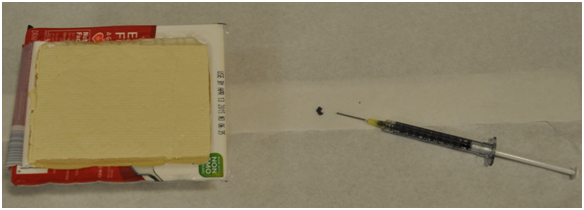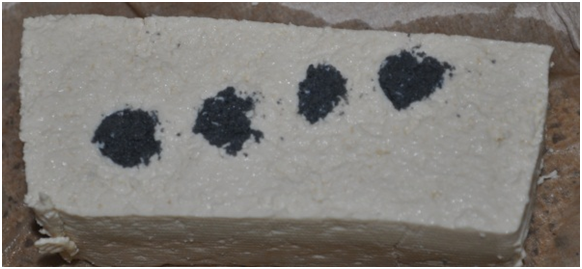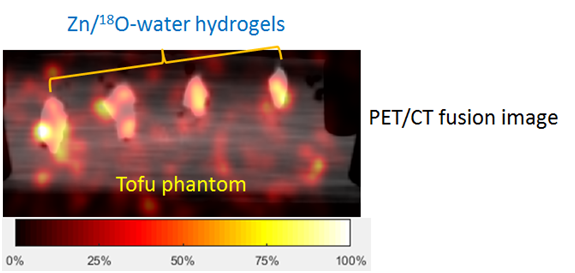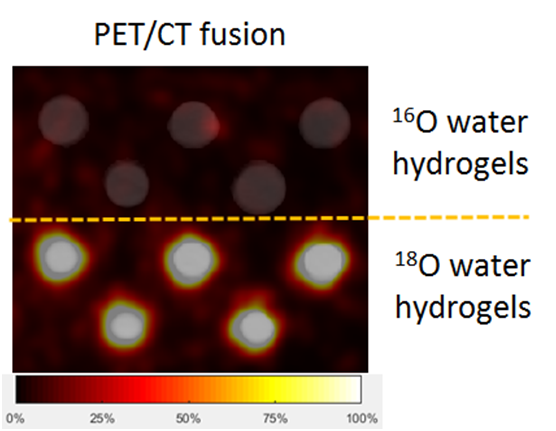글로벌 연구동향
의학물리학
![[Phys Med Biol.] Feasibility of hydrogel fiducial markers for in vivo proton range verification using PET.](/enewspaper/upimages/admin_20160414144835_R.png) 2016년 04월호
2016년 04월호
[Phys Med Biol.] Feasibility of hydrogel fiducial markers for in vivo proton range verification using PET.오클라호마 주립대학교/조종민*
- 출처
- Phys Med Biol.
- 등재일
- 2016 Feb 23
- 저널이슈번호
- 61(5):2162-2176.
- 내용


Figure 1. (Top) The tofu phantom and Zn/16O-water hydrogel in a syringe used in this research. (Bottom) Cross-section of the tofu phantom injected with Zn/16O water hydrogels.
이 연구에서 개발된 마커가 주사를 통해 두부에 주입되었습니다. 두부의 절단면을 통해 주입된 마커가 보입니다.


Figure 2. (Top) PET/CT fusion images of the tofu phantom injected with 0.9 cm3 of Zn/18O-water hydrogels (10%/90% mass ratio) and irradiated by a proton beam (2 Gy) from the bottom. (Bottom) PET/CT fusion images of 16O-water hydrogels (1.8 cm3) and 18O-water hydrogels (0.9 cm3) irradiated (2 Gy) in the dry Petri dish environment.
두부와 주입된 마커가 양성자치료후 PET으로 스켄되었습니다. 마커가 선명하게 PET에 보입니다.
Abstract
Biocompatible/biodegradable hydrogel polymers were immersed in 18O-enriched water and 16O-water to create 18O-water hydrogels and 16O-water hydrogels. In both cases, the hydrogels were made of ~91 wt% water and ~9 wt% polymer. In addition, 5-8 μm Zn powder was suspended in 16O-water and 18O-enriched water and cross-linked with hydrogel polymers to create Zn/16O-water hydrogels (30/70 wt%, ~9 wt% polymer) and Zn/18O-water hydrogels (10/90 wt%), respectively. A block of extra-firm 'wet' tofu (12.3 × 8.8 × 4.9 cm, ρ ≈ 1.05 g cm-3) immersed in water was injected with Zn/16O-water hydrogels (0.9 ml each) at four different depths using an 18-gauge needle. Similarly, Zn/18O-water hydrogels (0.9 ml) were injected into a second tofu phantom. As a reference, both 16O-water hydrogels (1.8 ml) and 18O-water hydrogels (0.9 ml) in Petri dishes were irradiated in a 'dry' environment. The hydrogels in the wet tofu phantoms and dry Petri dishes were scanned via CT and images were used for treatment planning. Then, they were positioned at the proton distal dose fall-off region and irradiated (2 Gy) followed by PET/CT imaging. Notably high PET signals were observed only in 18O-water hydrogels in the dry environment. The visibility of the Zn/16O-water hydrogels injected into the tofu phantom was outstanding in CT images, but these hydrogels provided no noticeable PET signals. The visibility of the Zn/18O-water hydrogels in the wet tofu were excellent on CT and moderate on PET; however, the PET signals were weaker than those in the dry environment, possibly owing to 18O-water leaching out. The hydrogel markers studied here could be used to develop universal PET/CT fiducial markers. Their PET visibility (attributed more to activated 18O-water than Zn) after proton irradiation can be used for proton therapy/range verification. More investigation is needed to slow down the leaching of 18O-water.
Author information
Cho J1, Campbell P, Wang M, Alqathami M, Mawlawi O, Kerr M, Cho SH.
1Department of Radiation Physics, The University of Texas MD Anderson Cancer Center, Houston, TX 77030, USA.
- 연구소개
- 양성자치료는 효과적인 암치료방법이기는 하나 양성자빔의 인체내에서의 거리계산이 부정확하게 될경우암을 제대로 치료 못하거나 건강한 인체기관을 방사선으로 치료하는등 위험할수 있습니다. 이 연구에서 저희는 환자몸에 주사로 주입할수 있는 마커를 개발했습니다. 이 마커는 방사선치료전에 사용되는 금마커 (gold fiducial marker)처럼 주입할수 있으며 치료전에 방사선을 정확하게 쏠수 있게하는 마커의 역할을 합니다. 치료후에는 양성자가 마커를 방사성 (radioactive)으로 만들기에 PET으로 정확한 치료 여부를 확인할수 있습니다.
- 덧글달기







